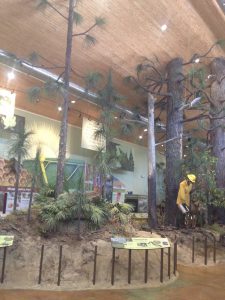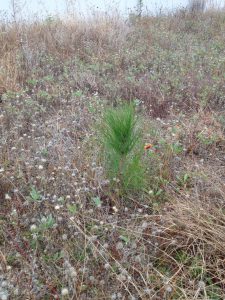
The longleaf forest display at the E.O. Wilson Biophilia Center shows typical vegetation and wildlife in the forest. Photo credit: UF IFAS Extension
Pine trees are so common in the southeastern United States that they are often taken for granted. They are usually the first to be cut down when homeowners are nervous about storms, and unless you’re in the tree-growing business, they are not considered all that valuable. However, the history and development of northwest Florida is intrinsically tied to the stately pine. During the 19th and early 20th centuries, the “naval stores” industry employed thousands of people collecting resin from pine trees. This industry produced turpentine and rosin used most famously to waterproof wooden ships, but also for soap, paint, inks, varnish, and medications.
Our area is home to seven native species, and each fulfills a specific role in the environment. In fact, during Florida Master Naturalist Program classes, we teach about pines living in all three of the broad Florida habitat types—uplands, freshwater wetlands, and coastal areas. These species can be difficult to tell apart, but a few tricks can help keep them straight.
The best way to keep track of pines is to recall that species starting with “S” (sand, shortleaf, spruce) have needles in bunches of twos (the letter S has two endpoints), and pines starting with “L” (a letter with 3 endpoints) have bunches of three (loblolly, longleaf). Finally, slash pine, starting with “SL” has bundles of 2-3 needles. Pond pine is an anomaly in that its shorter needles are in bunches of 3-5 needles.
A few interesting facts on some of our native pine species:
- The Southeast was once covered in over 60 million acres of longleaf pine forests, the namesake of an ecological habitat that encompasses many valuable and endangered species, including bobwhite quail, red-cockaded woodpeckers, gopher tortoises, and indigo snakes. Wind resistant and adapted to frequent fires, the trees can grow 80-100 feet tall. One of the largest stands of longleaf pine in Florida is at Eglin Air Force Base.
- Pond pine often grows along the edges of wetlands and ponds. Its cones may stay closed on the tree for up to eight years, but if a fire comes through they will immediately open and release their seeds. This adaptation allows the species to take advantage of open soil in full sun after a fire to germinate new trees.
- Sand pine can grow in extremely sandy, low-nutrient soils, including beach dunes on the Gulf and Atlantic coasts. They have very short needles (2-3 inches long), and the “Choctawhatchee” variety of sand pine works well as a Christmas tree.
For detailed information on identifying all seven species along with several introduced pines, please see the new UF publication, “Common Pines of Florida.”
- Yucca–A Tough and Versatile Native Plant - November 26, 2025
- Blazing Star - November 6, 2025
- University of West Florida’s New Heritage Roots Garden - October 17, 2025

